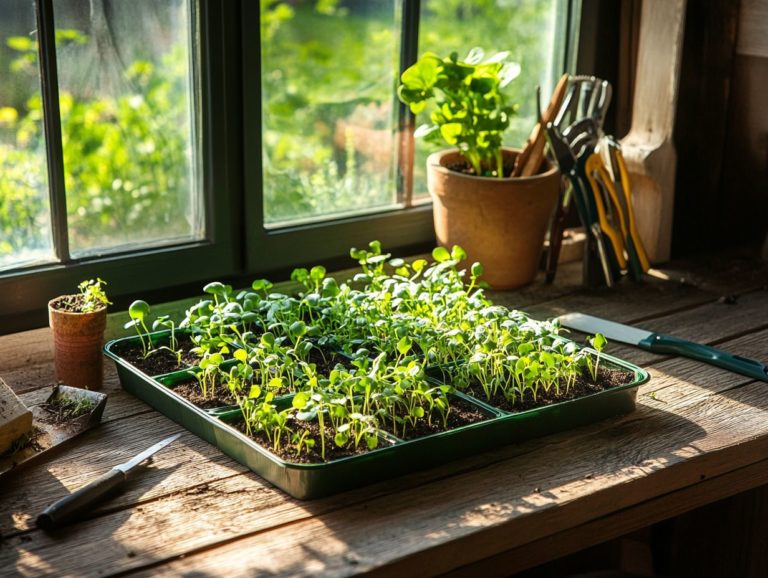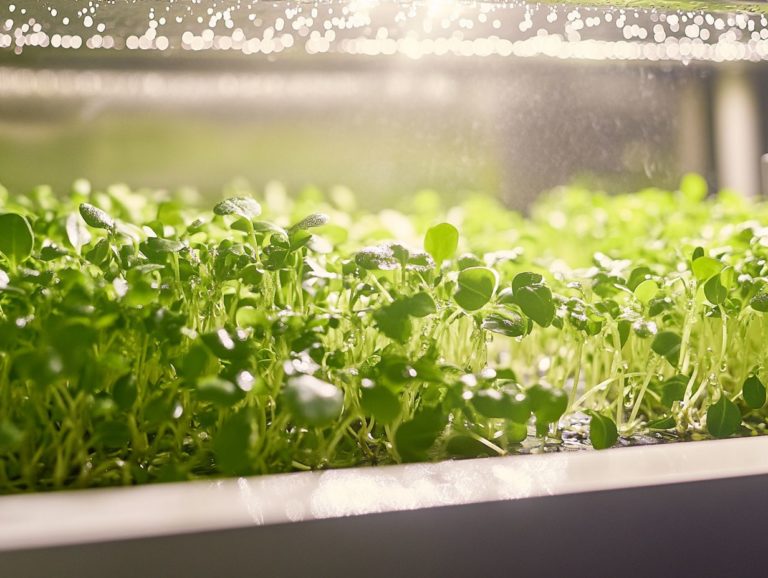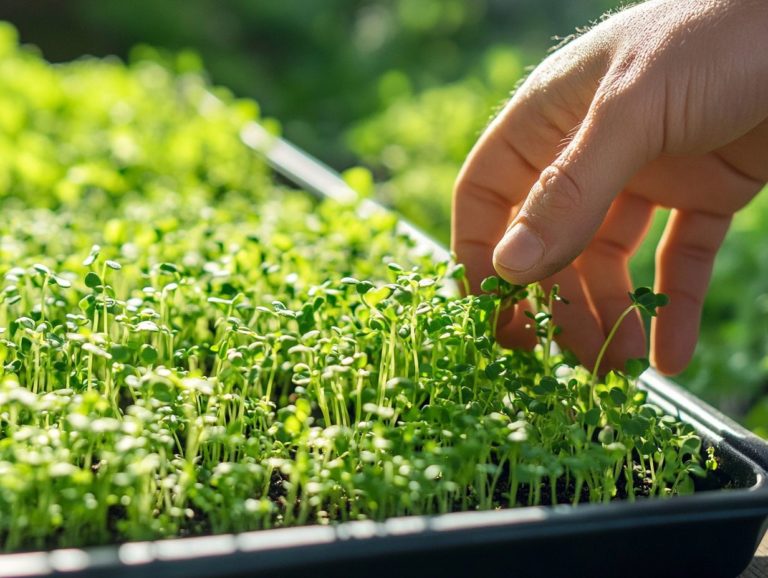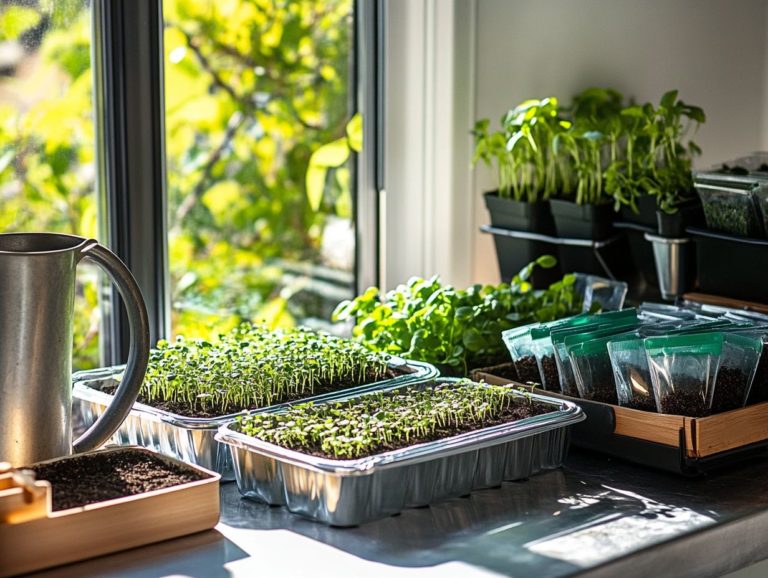Soil Alternatives for Microgreen Growing
Microgreens bring a burst of color and flavor to your kitchen, all while being packed with nutrients.
As you venture beyond traditional soil gardening, you will discover various alternatives that each offer their unique benefits and challenges.
Get ready to explore the best soil alternatives for growing microgreens, including hydroponic systems, vermiculite, and coir. You will learn how to set up these methods, along with their pros and cons, and gain valuable tips for ensuring successful growth.
Whether you’re a seasoned gardener or just beginning your journey, a wealth of insight awaits you to elevate your microgreen experience.
Contents
- Key Takeaways:
- Suitable Soil Alternatives
- Hydroponic Options for Microgreens
- Growing Microgreens in Vermiculite
- Using Coir as a Soil Alternative
- Other Soil Alternatives for Microgreens
- Frequently Asked Questions
- What are some common soil alternatives for microgreen growing?
- Why might one choose to use a soil alternative for microgreen growing?
- How do I prepare a soil alternative for microgreen growing?
- Can I use compost as a soil alternative for microgreen growing?
- Are there any eco-friendly soil alternatives for microgreen growing?
- Can I reuse soil alternatives for microgreen growing?
Key Takeaways:
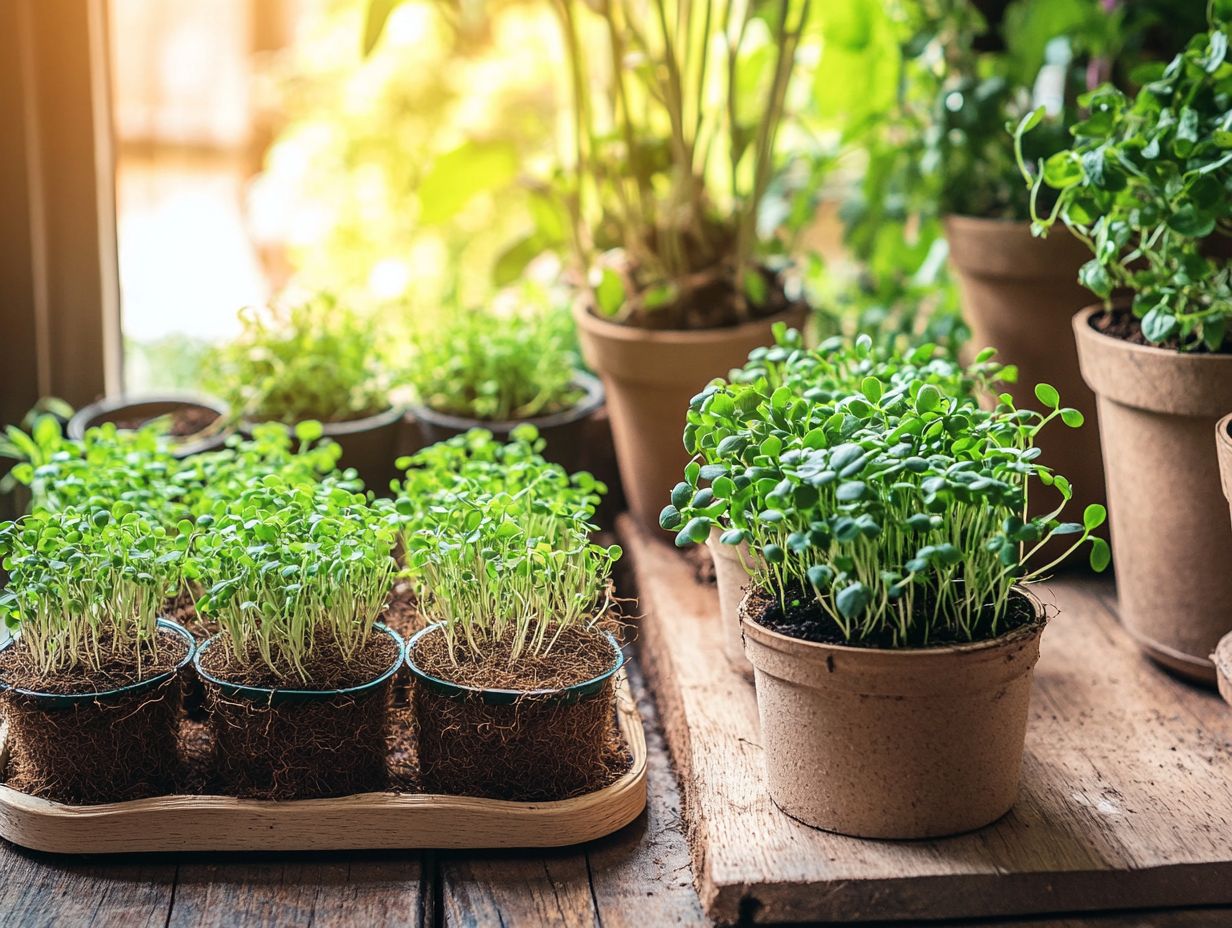
- Using soil alternatives for growing microgreens can provide numerous benefits, such as better water retention and reduced risk of pests and diseases.
- Hydroponic systems offer a soil-free option for growing microgreens but require careful setup and maintenance.
- Coir and vermiculite are popular and effective soil alternatives for microgreens. It’s important to consider factors like cost and nutrient availability when choosing the best option.
What are Microgreens?
Microgreens are delightful young plants that you can harvest early, usually ranging from 1 to 3 inches tall. They burst with flavor, showcase vibrant colors, and pack a diverse range of nutrients, making them increasingly popular among indoor gardeners and health aficionados.
Varieties like mustard, arugula, basil, and Swiss chard elevate your culinary creations while offering an impressive array of health benefits thanks to their high nutritional value and bioactive compounds. Bioactive compounds are natural substances in food that have health benefits.
These tiny powerhouses are great for enhancing salads, sandwiches, and garnishes, transforming everyday meals into culinary masterpieces. Germination rates can vary widely depending on the type, with some seeds sprouting in just a few days ideal for those quick harvests you crave.
Beyond their culinary charm, microgreens are celebrated for their rich concentrations of vitamins, minerals, and antioxidants, which can support a healthy diet and may even help lower the risk of chronic diseases. Add these vibrant greens to your meals to enhance texture and flavor and enrich the nutritional profile of your dishes, appealing to both gourmet cooks and health-conscious diners alike.
Suitable Soil Alternatives
Discovering the right soil alternatives for cultivating microgreens can significantly enhance your clean growing approach. This promotes strong plant growth and reduces concerns like E. coli contamination.
You can replace traditional soil with exceptional mediums, including potting mix, jute fiber, and specially designed fiber pads that ensure optimal drainage and aeration. These alternatives simplify the management of your indoor microgreen crops, allowing you to cultivate with confidence and ease. For those looking to enhance their growing experience, consider using the best containers for microgreen cultivation.
Benefits and Drawbacks of Using Soil Alternatives
Using soil alternatives to grow microgreens presents a mix of advantages and challenges that you should carefully weigh. Options like jute fiber and potting mix can offer a cleaner growing method and enhance nutrient uptake, but they might also introduce issues with moisture retention and germination rates.
Employing these alternatives can significantly reduce the risk of pests and diseases, fostering a healthier environment for your delicate seedlings. This often leads to improved germination rates, as your microgreens face fewer disturbances from soil-borne pathogens. To further enhance your growing experience, consider exploring understanding microgreen growing supplies.
Remember that some of these soil substitutes may require additional nutrients like nitrogen or phosphorus for optimal growth. Navigating these pros and cons will enable you to make informed choices, ultimately ensuring a successful indoor microgreen gardening experience with the help of natural fertilizers for microgreen growth.
Hydroponic Options for Microgreens
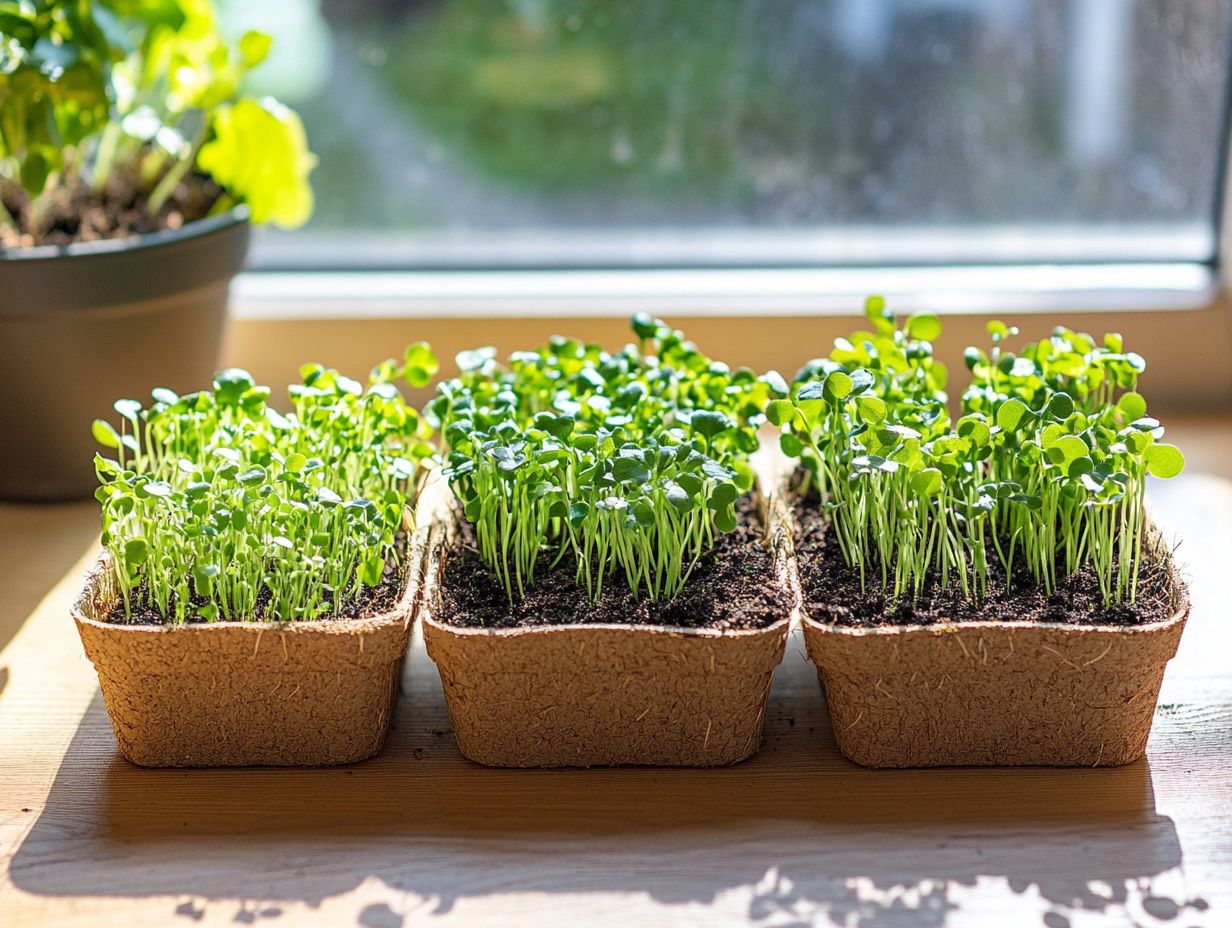
Hydroponic systems offer you remarkable opportunities to grow microgreens without relying on traditional soil, enabling you to cultivate your crops using nutrient-rich water solutions. This innovative method helps plants grow well and makes your gardening easier by minimizing the risk of soilborne pathogens and pests!
Embrace this clean method and watch your indoor garden thrive!
How to Set Up a Hydroponic System for Microgreens
Setting up a hydroponic system for your microgreens requires selecting the right equipment and creating the ideal growth environment, including water, nutrients, and seed trays. By utilizing a seed heating mat, you can significantly enhance germination rates, ensuring your microgreens flourish from the very beginning.
To get started, gather essential materials: a reservoir for water, a pump to circulate your nutrients, and grow lights to provide optimal light exposure. Choose medium trays that offer adequate drainage while still retaining moisture, and consider investing in a pH meter (a tool to measure acidity levels in water) to regularly check acidity levels.
Once your initial setup is complete, the next step is to mix your nutrient solution meticulously, ensuring it s perfectly balanced for microgreens. Keep a close eye on water levels to prevent them from drying out and to maintain nutrient concentration.
As your microgreens begin to grow, adjusting light intensity and duration can have a profound impact on their development. It s crucial to observe their response and tweak conditions as needed to achieve the best results.
Growing Microgreens in Vermiculite
Growing microgreens in vermiculite is a better choice compared to traditional potting mixes. This remarkable growing medium excels in aeration and moisture retention, delivering essential nutrients that promote robust plant growth.
You’ll find that its lightweight nature is particularly appealing, especially for indoor gardening. Not only does it support a diverse array of microgreen species, but it also streamlines the harvesting process. For more insights, check out the best resources for microgreen growing, making your gardening experience both efficient and rewarding.
Steps for Growing Microgreens in Vermiculite
To grow microgreens in vermiculite effectively, you should follow a series of steps that guarantee optimal germination rates and robust plant development. Begin by preparing the vermiculite soak it in water to provide the essential moisture before sowing your chosen seeds to promote rapid growth.
Selecting the right variety of seeds is pivotal; popular choices include broccoli, arugula, and radish, all of which thrive in this medium. Once you’ve soaked the vermiculite, which enhances moisture retention and improves aeration, spread a layer about one to two inches deep in a shallow tray. To learn more about the ideal growing conditions, check out the best substrates for microgreen growing and harvest.
After evenly sprinkling the seeds across the surface, gently press them down to ensure good contact. Cover the tray with a lid or plastic wrap to create a greenhouse effect that fosters a warm environment. Regularly check the moisture level and use a spray bottle to mist the surface, taking care not to oversaturate.
As soon as the seeds sprout, exposing them to light becomes essential for healthy growth. Periodic monitoring will ensure they receive the necessary nutrients for robust development, setting you on the path to flourishing microgreens.
Using Coir as a Soil Alternative
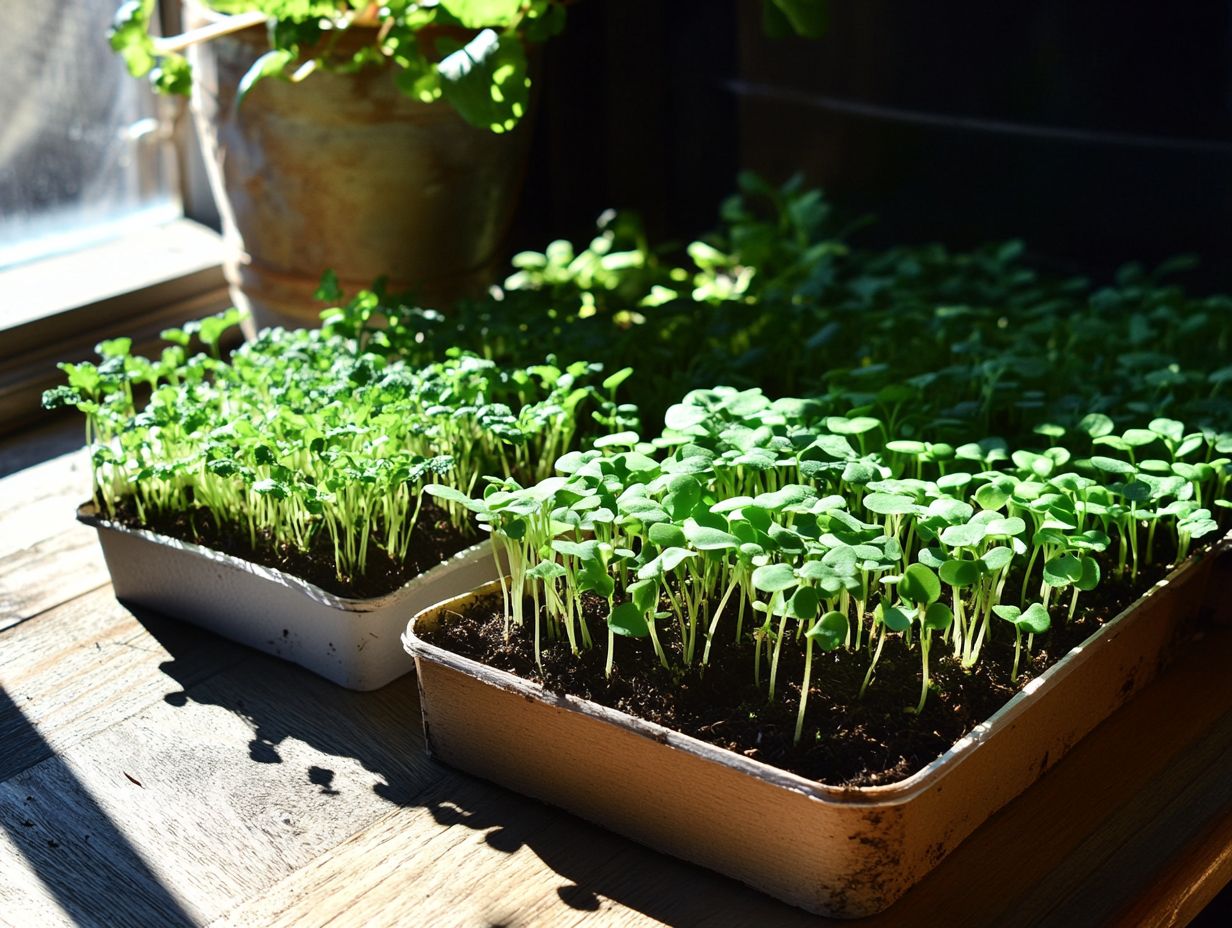
Coir, sourced from coconut husks, has become a highly sought-after soil alternative for cultivating microgreens, celebrated for its sustainability and effectiveness in fostering a pristine growing environment.
This organic medium not only offers exceptional aeration and moisture retention but also contains essential nutrients, solidifying its status as a favored choice among indoor gardeners.
Ready to boost your gardening game? Growing microgreens in coir is a smart choice!
Growing microgreens in coir brings a wealth of benefits to your gardening endeavors, including improved drainage and higher germination rates. It also supplies essential nutrients for robust plant development. To fully harness these advantages, you should follow specific guidelines for preparing and maintaining coir throughout the growing journey.
This remarkable natural fiber, derived from coconut husks, enhances root aeration and aids in moisture retention, ensuring that your microgreens receive consistent water. If you’re curious about the best options for growing microgreens, consider exploring what soil is best for microgreens. Beyond its agricultural perks, coir stands out as an eco-friendly choice, using a leftover product from coconut production, thereby helping to reduce waste.
For optimal results, it’s wise to soak the coir bricks in water before use to fully expand them. Keep a close eye on moisture levels to prevent over-saturation. Mixing coir with compost enhances nutrient content, giving your microgreens the perfect boost for vigorous growth.
Other Soil Alternatives for Microgreens
Exploring various soil alternatives for growing microgreens can elevate your gardening experience. Consider hydroponic systems methods of growing plants without soil, using nutrient-rich water instead that completely eliminate soil. You can also experiment with unique mixtures like perlite and coconut coir.
Each alternative presents its own distinct benefits and challenges regarding nutrient delivery and plant growth. To learn more about what containers you can use for microgreens, you can discover what works best for you.
Comparison and Considerations
When exploring soil alternatives for growing microgreens, it’s essential to weigh factors like nutrient availability, moisture retention, and the overall cleanliness of your growing method. Each growing medium has unique characteristics that can influence germination rates and plant health.
Take options like coconut coir, peat moss, and hydroponic systems, for example. They can differ greatly in their ability to supply essential nutrients. Coconut coir is fantastic for moisture retention, but you might need to supply extra fertilization since it tends to be low in nutrients. Peat moss is lightweight and promotes good aeration, but watch out for its acidity. Meanwhile, hydroponic systems allow for direct nutrient absorption by the roots, which can lead to impressive growth rates. Additionally, using sprouting trays for microgreens can enhance your growing experience.
As you choose your growing medium, let the specific type of microgreen you’re cultivating guide your decision. Some varieties may flourish in organic setups, while others might thrive in a soilless environment. Choose wisely, and watch your microgreens thrive.
Frequently Asked Questions

What are some common soil alternatives for microgreen growing?
Some common soil alternatives include coir, peat moss, vermiculite, perlite, and rockwool.
Why might one choose to use a soil alternative for microgreen growing?
Using a soil alternative can help eliminate the risk of soil-borne diseases and pests. It can also offer better drainage and aeration for the microgreens.
How do I prepare a soil alternative for microgreen growing?
The preparation process varies depending on the soil alternative chosen. Generally, it involves moistening the material and allowing it to drain before adding seeds or transplants.
Can I use compost as a soil alternative for microgreen growing?
While compost can be a great source of nutrients, it may not provide the proper texture or drainage needed for microgreen growth. It is recommended to mix compost with other soil alternatives for the best results.
Are there any eco-friendly soil alternatives for microgreen growing?
Yes, some eco-friendly options include coconut coir, which is a byproduct of the coconut industry, and perlite, which is made from volcanic glass.
Can I reuse soil alternatives for microgreen growing?
Some soil alternatives, such as rockwool and vermiculite, can be reused multiple times before needing to be replaced. However, it is important to properly sanitize them between uses to prevent any potential contamination.
Have more questions? Share your thoughts below!


